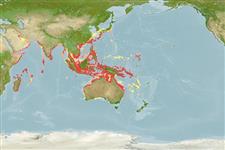>
Carangiformes (Jacks) >
Carangidae (Jacks and pompanos) > Caranginae
Etymology: Selaroides: A Malay vernacular name, ikan selar + Greek, suffix, oides = similar to.
More on author: Cuvier.
Environment: milieu / climate zone / depth range / distribution range
Écologie
marin; saumâtre récifal; amphidrome (Ref. 51243); profondeur 1 - 50 m (Ref. 90102). Tropical; 39°N - 34°S, 49°E - 170°E (Ref. 54888)
Indo-West Pacific: Persian Gulf to the Philippines, north to Japan, south to the Arafura Sea (Ref. 9819) and Australia (Ref. 3287).
Length at first maturity / Taille / Poids / Âge
Maturity: Lm 11.9, range 10 - ? cm
Max length : 22.0 cm TL mâle / non sexé; (Ref. 28620); common length : 15.0 cm TL mâle / non sexé; (Ref. 9137); poids max. publié: 625.00 g (Ref. 4883)
Épines dorsales (Total): 9; Rayons mous dorsaux (Total): 24-26; Épines anales 3; Rayons mous anaux: 21 - 23.
Adults occur in inshore waters of the continental shelf (Ref. 7300). They form large demersal schools over soft bottom habitats at depths shallower than 50 m. Sometimes they ascend into freshwater reaches like the freshwater tidal zone in the Mekong delta (Ref. 12693). Ostracods, gastropods and euphausiids are common prey but small fish are also taken.
Life cycle and mating behavior
Maturité | Reproduction | Frai | Œufs | Fécondité | Larves
Paxton, J.R., D.F. Hoese, G.R. Allen and J.E. Hanley, 1989. Pisces. Petromyzontidae to Carangidae. Zoological Catalogue of Australia, Vol. 7. Australian Government Publishing Service, Canberra, 665 p. (Ref. 7300)
Statut dans la liste rouge de l'IUCN (Ref. 130435)
Menace pour l'homme
Harmless
Utilisations par l'homme
Pêcheries: commercial
Outils
Articles particuliers
Télécharger en XML
Sources Internet
Estimates based on models
Preferred temperature (Ref.
123201): 25.1 - 29.3, mean 28.6 °C (based on 2984 cells).
Phylogenetic diversity index (Ref.
82804): PD
50 = 1.0000 [Uniqueness, from 0.5 = low to 2.0 = high].
Bayesian length-weight: a=0.01318 (0.01178 - 0.01475), b=2.96 (2.93 - 2.99), in cm total length, based on LWR estimates for this species (Ref.
93245).
Niveau trophique (Ref.
69278): 3.8 ±0.2 se; based on diet studies.
Generation time: 1.2 (1.0 - 1.5) years. Estimated as median ln(3)/K based on 13
growth studies.
Résilience (Ref.
120179): Haut, temps minimum de doublement de population inférieur à 15 mois (K=0.5-1.3).
Prior r = 0.98, 95% CL = 0.65 - 1.47, Based on 2 stock assessments.
Fishing Vulnerability (Ref.
59153): Low vulnerability (14 of 100).
Climate Vulnerability (Ref.
125649): High vulnerability (56 of 100).
Nutrients (Ref.
124155): Calcium = 107 [61, 236] mg/100g; Iron = 1.24 [0.70, 2.23] mg/100g; Protein = 19.9 [18.0, 21.7] %; Omega3 = 0.184 [0.109, 0.315] g/100g; Selenium = 32.1 [17.3, 61.5] μg/100g; VitaminA = 81.4 [27.2, 250.5] μg/100g; Zinc = 1.5 [1.0, 2.1] mg/100g (wet weight); based on
nutrient studies.
